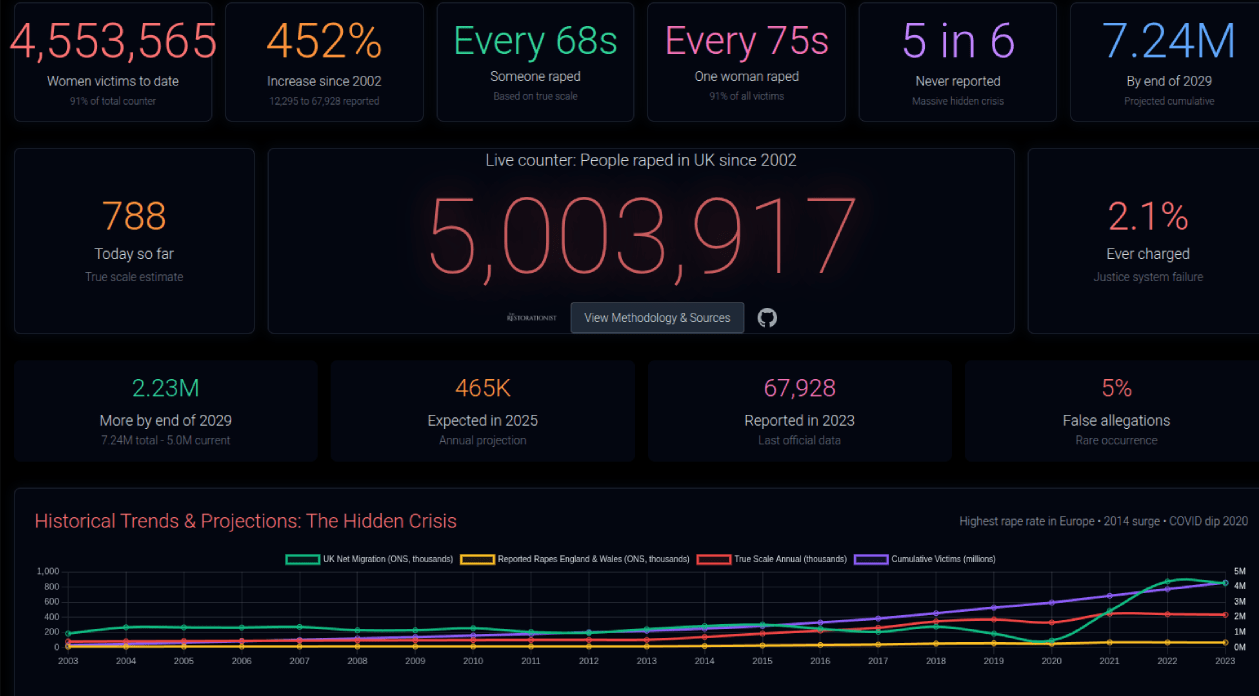The Equality Act (2010): Brown's Wealth Redistribution Instrument
The Equality Act has created a backward-looking financial model that bankrupts local authorities and a forward-looking cultural regime that punishes dissent. It has fused bureaucratic piety with legislative ambiguity, producing a climate of conformity cloaked in the language of fairness.

The Equality Act, introduced in the twilight of Gordon Brown's premiership, consolidated these nine major laws into a single statute under the banner of simplification. In doing so, it also expanded the scope of equality law. Transgender people, previously covered narrowly under the Gender Recognition Act 2004, were brought in via the protected characteristic of “gender reassignment.” Sexual orientation, only decriminalised fully in 2003 in some UK jurisdictions, was granted full protected status. Thus, what began as a project focused on race and sex was transformed into a comprehensive, sometimes coercive, framework of identity politics, crowbarring in categories that had never before been part of that original civil rights tradition. It is thus unsurprising that Gender Recognition Act "women" have been crowbarred back out, following For Women Scotland Ltd v Scottish Ministers [2025] UKSC 16.
Despite its cuddly name, and grandiose attempts to consolidate civil rights era legislation, this act has become a wealth redistribution instrument, with some censorship elements sprinkled in. In 2023, Birmingham City Council declared itself effectively bankrupt, the first major authority in England to issue a Section 114 notice in over a decade. The figure that finally brought Europe’s largest council to its knees was staggering: £760 million in equal pay liabilities. The origin of this debt? The Equality Act 2010.
The Equality Act 2010 is the culmination of decades of anti-discrimination legislation that began with the Race Relations Act 1965, the first law in the UK to outlaw racial discrimination in public places. This was followed by more expansive laws in 1968 and 1976, extending protections to employment and housing and establishing the Commission for Racial Equality. Parallel statutes emerged for sex (1975), disability (1995), and religion and belief (2003), forming a fragmented patchwork of protections.
What happened in Birmingham is not an isolated event, nor is it merely a story of administrative mismanagement. It is a vivid illustration of how a well-intentioned piece of legislation has become a mechanism of economic collapse and ideological conformity. Under the banner of fairness, the Act has licensed a bureaucratic crusade: retrospective compensation on one front, institutional self-censorship on another.
In legal terms, the central problem lies in the retrospective application of the Act’s equal pay provisions. These were not invented by the 2010 Act—they date back to the Equal Pay Act 1970—but the consolidated statute, interpreted through decisions like Birmingham City Council v Abdulla [2012] UKSC 47, has radically expanded their reach. In Abdulla, the Supreme Court allowed claimants to bypass employment tribunals altogether and sue in the civil courts up to six years after the end of their employment, thereby extending the liability window well beyond the original three-month deadline.
The court’s decision had enormous ramifications. Claims that were previously considered time-barred suddenly became live liabilities. In Birmingham’s case, these claims came from thousands of women—cleaners, carers, teaching assistants—arguing that they had historically been paid less than male workers in comparable roles. The law recognises such roles as “work of equal value.” And under Asda Stores Ltd v Brierley [2021] UKSC 10, the courts affirmed that even female shop workers could compare themselves to male warehouse workers at different sites, leading to what has become the largest equal pay claim in UK private-sector history.
Birmingham was not alone. Sheffield City Council faced a £100 million equal pay liability in 2022 and began emergency budgeting measures, slashing funding for libraries, adult services, and school infrastructure. Glasgow, too, has faced liabilities approaching £770 million. In each case, the application of the Equality Act has created a legal framework in which financial ruin becomes a necessary precondition of historical restitution.
What is striking about these cases is not that discrimination occurred, but that the legal regime encourages punitive backpay decades after the original policies were implemented. This represents a fundamental breach with one of the cornerstones of British law: legal certainty. As Lord Nicholls observed in Wilson v First County Trust Ltd (No 2) [2003] UKHL 40, retrospective legislation is “in general, contrary to the principle that individuals should be able to know the legal consequences of their acts at the time they act.” This principle is also embedded in statute under section 16(1)(c) of the Interpretation Act 1978.
Such massive liabilities do not only threaten the financial health of councils. They distort incentives across the public sector. Institutions that failed to reform past pay structures are punished with obligations they cannot possibly meet. And current services are cut to fund compensation for prior inequities, often calculated with the bluntest actuarial tools. The result is that the very councils meant to deliver equality in housing, education, and social care are forced to cannibalise themselves to meet legal obligations for past injustice.
If the fiscal cost of the Act is plain, its cultural cost is more diffuse—but equally corrosive.
The Public Sector Equality Duty (PSED), introduced under section 149 of the Equality Act, requires public bodies to “have due regard” to the need to eliminate discrimination and advance equality of opportunity. In practice, it has become a broad and ill-defined mandate, one that university administrators, civil servants, and NHS managers interpret not merely as a duty to treat people fairly, but as an obligation to enforce ideological conformity.
Take the case of Professor Kathleen Stock, who resigned from Sussex University in 2021 after sustained campaigns targeting her for expressing gender-critical views. These views were entirely lawful and, following Forstater v CGD Europe [2021] UKET 2200909/2019, are protected under the Equality Act itself as a philosophical belief. Yet the university’s management, facing pressure from students and diversity officers, effectively abandoned her. The justification? A perceived need to maintain “inclusive” and “safe” environments—language directly traceable to institutional interpretations of the PSED.
Nor is Stock an isolated example. Noah Carl was dismissed from Cambridge following vague accusations of association with discredited science, despite no proven academic misconduct. Student groups routinely cite the Equality Act as grounds for cancelling events or disinviting speakers. University bureaucracies increasingly rely on third-party guidance—most notably from Stonewall—treating it as quasi-statutory. This is despite the fact that much of Stonewall’s advice, including on matters such as pronoun use and gender identity training, has no basis in law.
The net effect is a system in which disagreement is treated as discrimination, and where ideological compliance is disguised as legal obligation. Speech once considered controversial but lawful is now actively discouraged. The compliance bureaucracy created by the Equality Act, in tandem with external activist pressure, functions as a modern censor. Not by banning speech outright, but by making its consequences professionally untenable.
And what of law itself? The confusion has now reached such a pitch that the UK Supreme Court in For Women Scotland Ltd v Scottish Ministers [2025] UKSC 16 was compelled to answer a question that would have been deemed absurd a generation ago: what is the legal definition of a “woman”?
The Scottish Government had attempted to include trans women with a Gender Recognition Certificate within the legal definition of “woman” for the purposes of public board quotas. The Court disagreed. It held that the Equality Act, in its proper interpretation, refers to biological sex. The Court noted in paragraph 2 of the judgment that its role was not to resolve social or political debates about sex and gender, but to ensure the statutory language remained coherent and legally workable.
This decision reasserted a principle of legal interpretation: that statutory terms must have predictable meanings, particularly when they govern access to single-sex spaces and protections. But it also revealed how far legislative drafting has drifted from common sense. If the courts must now clarify that “woman” means adult human female for legal purposes, the statutory framework has not clarified reality—it has obscured it.
We have created a situation where the judiciary must fix what Parliament, in its ideological exuberance, has rendered opaque.
The Equality Act was not passed in secret. It was openly celebrated as a modernisation of Britain’s equality framework. But its effects have been anything but modernising. It has created a backward-looking financial model that bankrupts local authorities and a forward-looking cultural regime that punishes dissent. It has fused bureaucratic piety with legislative ambiguity, producing a climate of conformity cloaked in the language of fairness.
If the aim of equality law was to promote justice, its current form betrays that purpose. The time has come to reconsider the architecture. Not to strip away all protections, but to recover the principles that once grounded British public law: legal clarity, financial proportionality, and freedom of thought.
What began as a civil rights statute has become an instrument of ideological enforcement. In the name of 'equality', we have created a system that punishes the past and polices the present. That is not law. It is creed, emblematic of why such cosily named legislation must be repealed en masse.




